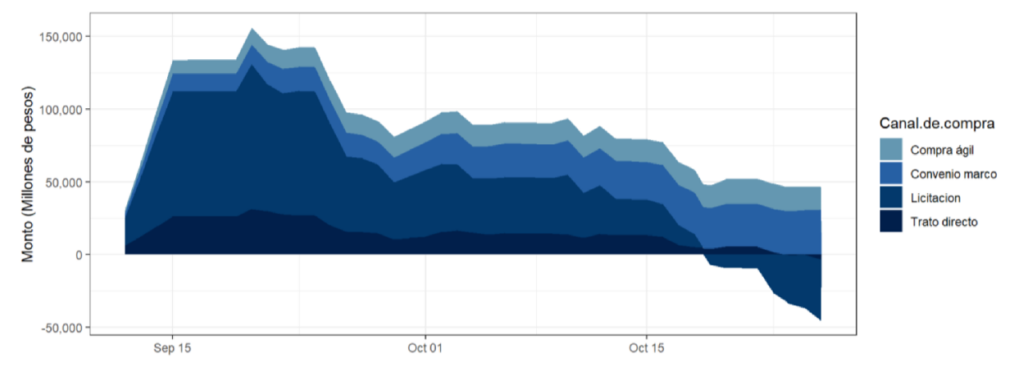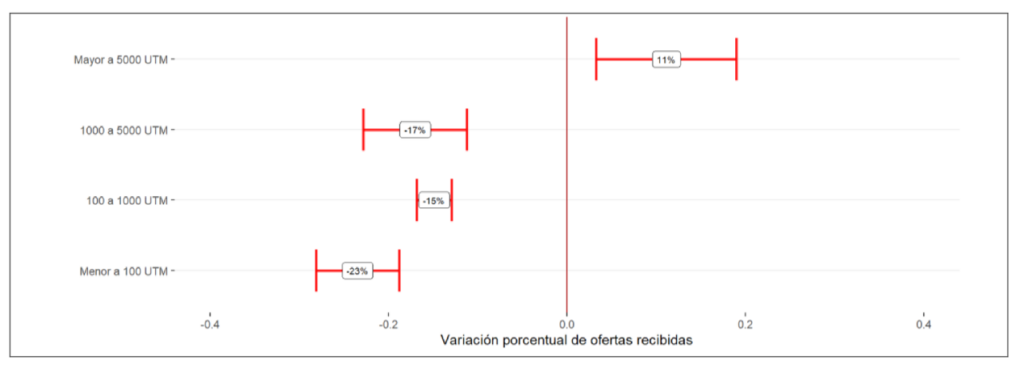Lessons from a weeklong shutdown of ChileCompra’s e-procurement system

Few things demonstrate the value of electronic government procurement (e-GP) systems as effectively—yet undesirably—as an unexpected, system-wide blackout that halts the functioning of the entire public procurement market. This is precisely what happened to ChileCompra between September 12 and 19, 2023.
OCP partnered with the University of Chile to conduct an analysis showing that the event had a limited overall impact on the total monetary value of public procurement transactions, as all postponed purchases were eventually completed—within the official system, not outside of it—in the weeks that followed [see figure 1]. Despite Chile’s usual “use it or lose it” approach to procurement spending, buyers appeared to prefer waiting for the platform to come back online rather than issuing paper-based direct purchase orders.

This cautious behavior of procurers suggests a few important things:
- First, it reflects a sense of administrative efficiency, as procurers seem to perceive the transaction costs of operating within the official platform as lower than managing purchases through alternative channels. And they did so primarily through public tenders rather than other “fast-track” methods available in the platform.
- Second, it shows institutional caution. Many buyers may have feared that bypassing the system through exceptional, paper-based direct contracts would trigger stricter audits or expose them to greater administrative risk.
Together, these factors likely reinforced a strategic choice to delay purchases rather than deviate from standard procedures.
Regarding supplier participation, there are two figures worth highlighting due to their contrasting trends. Smaller tenders under 5,000 UTM (<USD 350,000) experienced a significant drop in participation, with 15% to 23% fewer offers. This effect increases as the amount decreases. In contrast, larger tenders (over 5,000 UTM) saw an increase in participation, around 11% [see figure 2].

Again, two key lessons can be derived here. Small companies, which tend to participate in lower-value opportunities (under 5,000 UTM), were comparatively more affected than larger firms—highlighting that the promise of market openness through an e-GP system is not just theoretical, but grounded in real impact. Larger—and likely more complex—business opportunities, those exceeding 5,000 UTM (>USD 350,000), could benefit from a longer average publication period. This would help ensure that all qualified suppliers have sufficient time to prepare and submit their proposals.
Alternatively, some of the increase in higher-value tenders could reflect a shift away from process fragmentation, with smaller contracts being bundled into larger procurements—not necessarily more complex ones. Better data and use of the planning stage would help assess this possibility.
This event clearly shows that electronic procurement systems (e-GP) deliver on one of their core promises: expanding opportunities for supplier participation—especially for small and medium-sized enterprises. But beyond that, it also underscores the importance of open government procurement that ensures transparency, resilience and market access.
The case reinforces OCP’s long-standing advocacy for digitalization and openness in public procurement. Resilient digital systems not only ensure operational continuity, but also foster trust and accountability.
At the same time, it highlights the significant institutional capacities that ChileCompra has built over time—strong enough that, even under stress, both buyers and processes remained aligned with the formal system. It is a powerful reminder that technology and institutional maturity must always go hand in hand.